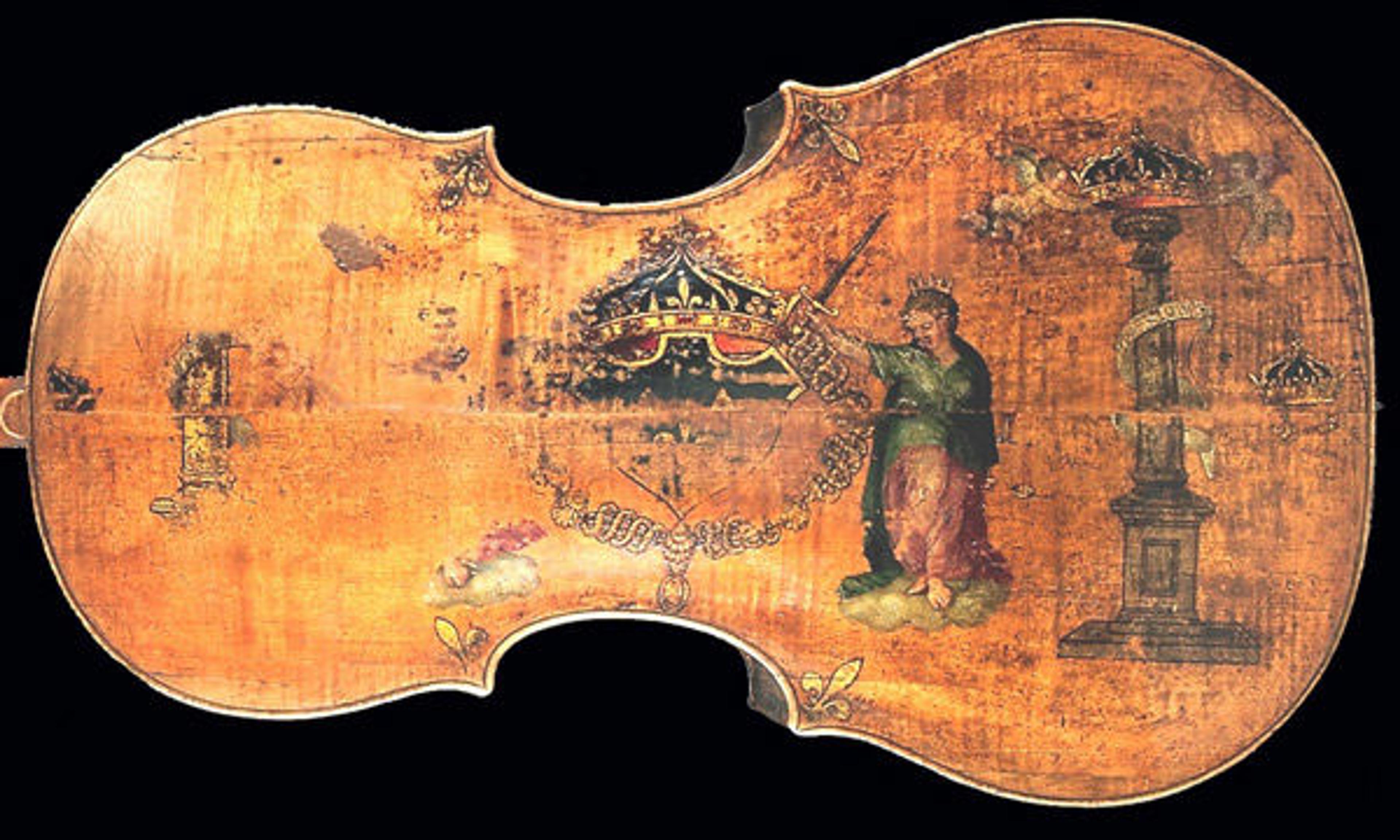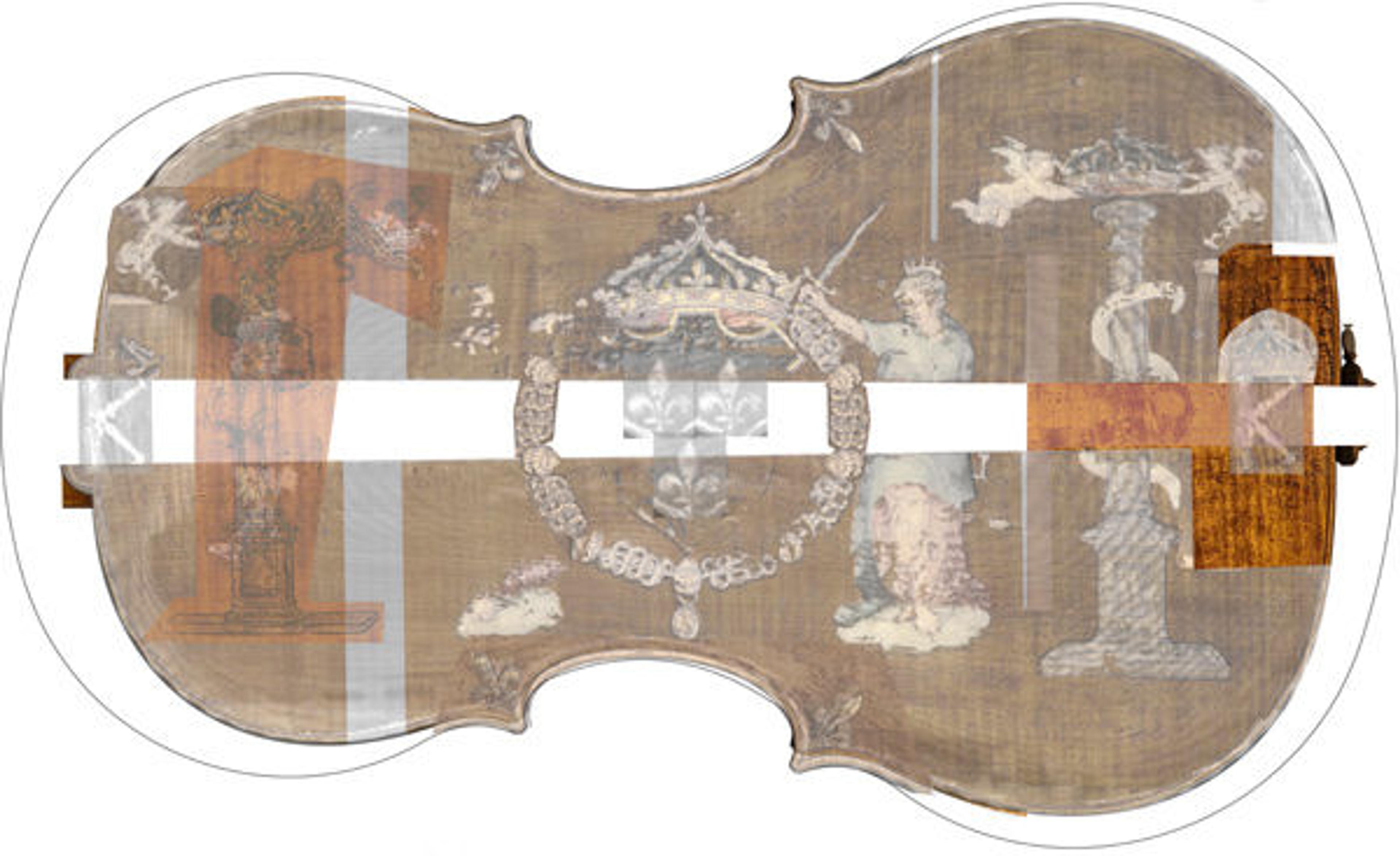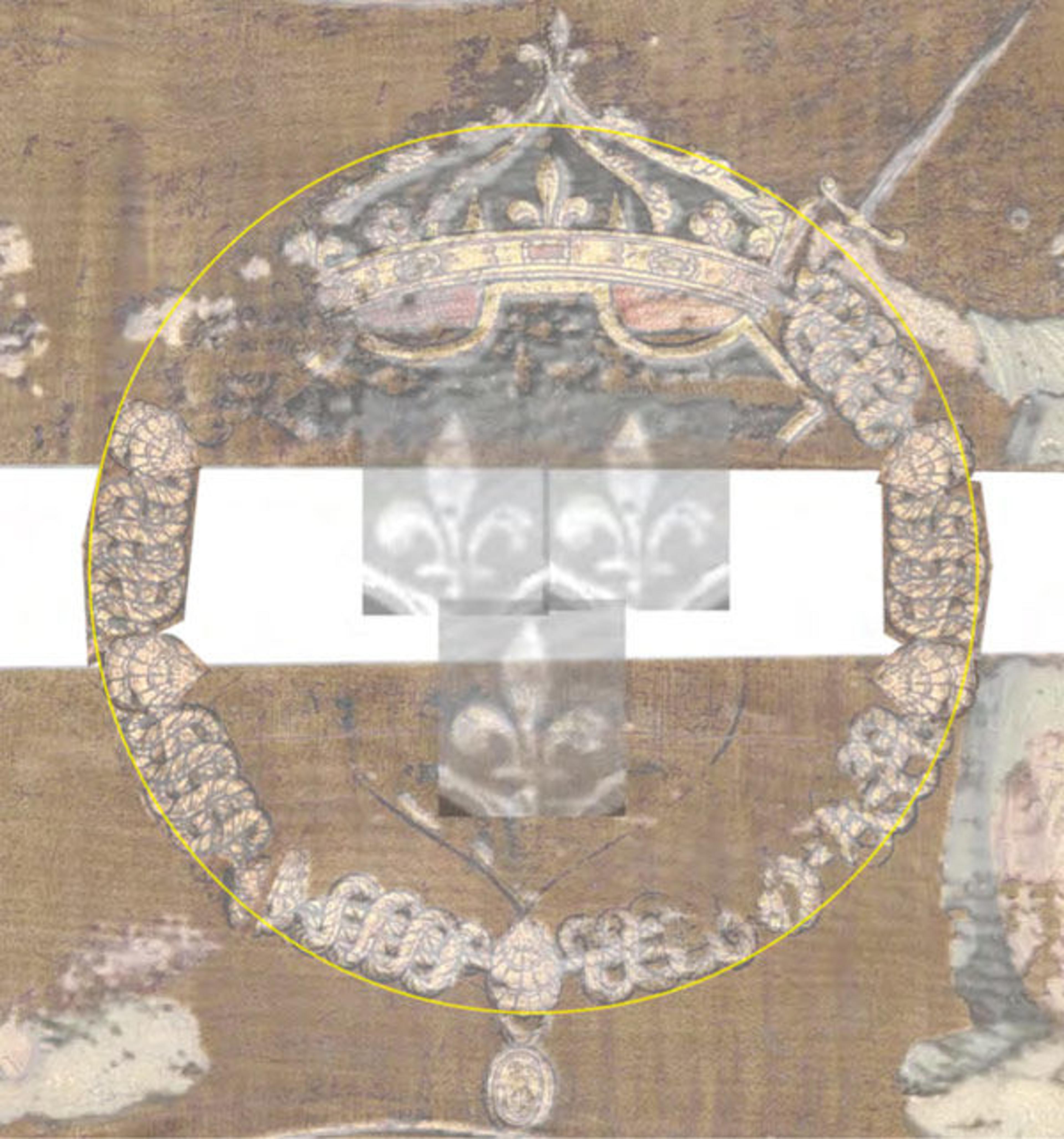
Andrea Amati (Italian, ca. 1505–1578). Violoncello, "The King" (detail), mid-16th century. National Music Museum, Vermillion, South Dakota, Witten-Rawlins Collection, 1984 (NMM 3351)
«The "King" cello, on loan to The Metropolitan Museum of Art from the National Music Museum through September 8, is a rare surviving example from the decorated set of instruments made in the mid-sixteenth century by Andrea Amati and presented to King Charles IX of France. The "King" has been reduced in size from a large basso, or bass violin, to a modern-day cello. Without this reduction in size, the "King" may have been neglected or lost to time as many other fine instruments have been, and we would be at a loss without its incomparable beauty.»
Little is known about the reduction of the "King" other than the basic information gained from an inscription on the inside of the instrument's back, which reads: "Mended by Renault Luthier, St. avoÿe street, __ 8_ Paris 1801." It cannot be said with certainty that the luthier Sébastien Renault, who was active in Paris from about 1765 to 1811, was responsible for the current state of the instrument in its entirety, but it certainly appears that he worked on the cello, in Paris, at some point during 1801. There are no known surviving bassos by Amati that exist in their original dimensions. Therefore, to know the instrument's relation to the rest of the violin family and to understand its place in the musical culture of the sixteenth century, an estimation of its original size must be created.
The decorations on the "King" provide evidence that serves as a base for reconstructing an estimation of the instrument's original outline. By comparing the cello's decorations to those of the other surviving members of the Charles IX set, an approximation of the original iconographic material can be made. The overall scheme of the icons can be divided into five elements: the Royal Arms of France, the figures of Piety and Justice, the fleurs-de-lis in the corners of the instrument, the columns with winding ribbons and the putti placing crowns atop them, and, finally, the Ks surmounted by crowns. Many techniques have been employed to recreate the original decorations—including visual inspection, digital photography, ultraviolet-fluorescence photography, infrared inspection, X-ray by computed tomography scans, and digital comparisons and overlays with other instruments of the Charles IX set.

Digital reconstruction of the cello's back, showing original size and placement of various decorations. Image courtesy of the author
Careful examination of the cello reveals that the instrument has not been reduced symmetrically, nor have the belly and back been reduced in exactly the same manner. On the back, a wedge-shaped strip of material has been removed from its center, most easily seen with the loss of the central portion of the Royal Arms of France and the torso of Justice. The column, with its top portion leaning awkwardly away from its base, is also a clear indication of the material removed from the center.
The first step in reconstructing the decorations is simply straightening the column in the lower bout, which yields the general shape of the strip removed but does not define its width. This also orients the top half of Justice's body, so that she is not quite as hunched over, and puts the top line of the shield in the Royal Arms on the horizontal plane.
Understanding that the surviving woodwork has been altered is critical in reconstructing the decorations, as it directly affects the governing principle of symmetry. More aptly, the distance of the decorations to the edges of the middle bouts defines the vertical symmetry of the decorations. A greater amount of material has been removed from the treble-side edges of the instrument than from those on the bass side, which is most readily visible in the middle bouts. The middle bout and corners on the bass side of the back are unaltered examples of Amati's work; however, the middle bout and corners of the treble side have been recarved, effectively moving the edge inward. This, in combination with the strip of material removed from the center, has made the waist smaller.
The central motif, the Royal Arms of France, consists of a shield containing three fleurs-de-lis and the king's crown, bound by the Collar of the Order of Saint Michael, a chivalric order founded by Louis XI. The removed central strip neatly bisects the seashells in the collar. One full section of cord, consisting of four windings and half of each seashell bordering those sections, was removed from both sides of the collar. If the circle used for the shape of the collar encloses both the cord and the whole crown apart from its cross at the top, the symmetry of the design is maintained, thus making the medallion at the base of the Order of Saint Michael and cross at the top of crown symmetrically opposed.

Digital reconstruction of the Royal Arms of France and the Collar of the Order of Saint Michael on the cello's back. Image courtesy of the author
The straightening of the column and reconstruction of the Royal Arms provides a framework for placing the rest of the iconographic elements. Two Amati instruments from the Charles IX family now housed in British museums provide more clues for reconstructing the "King." The "Tullie House" violin and "Ashmolean" viola, respectively located in the Tullie House Museum in Carlisle, and the Ashmolean Museum in Oxford, share the same iconographic scheme as the "King." The columns on both of these instruments show that the space between the windings of the ribbons around the columns decreases toward the center of the instrument. Using these two instruments as a guide, in combination with X-ray and ultraviolet-fluorescence imaging of the "King," the columns, ribbons, and putti were reconstructed. The Ks surmounted with crowns were estimated using X-ray imaging of decorations present on the ribs of the cello.
Unfortunately, Piety is almost completely worn off, but enough of Justice remains to show that this is a reasonable reconstruction. The fleurs-de-lis in the corners are determined to be not original to the instrument, as the gold leaf used in their application is different than that which is present on the rest of the instrument, and their placements vary considerably. Furthermore, similar decorations are not present on the corners of any other member of the Charles IX set that share the same iconographic scheme as the "King" cello. They were likely added at the time of the reduction, possibly to draw the eye away from the alterations made to the corners.
Finally, an outline must be added to the framework of the decorations. The geometric principles used to establish the outline are a source of ongoing scholarly debate. The outline used in this estimation is based on the geometry of the "Ashmolean" viola, the only known viola by Amati that retains its original dimensions. This is just one possible recreation of the original outline of the "King" cello, but, so far, it seems to be the most plausible.